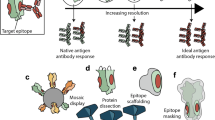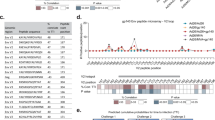Polyvalent vaccines for optimal coverage of potential T-cell epitopes in global HIV-1 variants (original) (raw)
- Technical Report
- Published: 24 December 2006
- Simon Perkins1 na1,
- James Theiler1,
- Tanmoy Bhattacharya1,2,
- Karina Yusim1,
- Robert Funkhouser1,
- Carla Kuiken1,
- Barton Haynes3,
- Norman L Letvin4,
- Bruce D Walker5,
- Beatrice H Hahn6 &
- …
- Bette T Korber1,2
Nature Medicine volume 13, pages 100–106 (2007)Cite this article
- 4324 Accesses
- 355 Citations
- 29 Altmetric
- Metrics details
Abstract
HIV-1/AIDS vaccines must address the extreme diversity of HIV-1. We have designed new polyvalent vaccine antigens comprised of sets of 'mosaic' proteins, assembled from fragments of natural sequences via a computational optimization method. Mosaic proteins resemble natural proteins, and a mosaic set maximizes the coverage of potential T-cell epitopes (peptides of nine amino acids) for a viral population. We found that coverage of viral diversity using mosaics was greatly increased compared to coverage by natural-sequence vaccine candidates, for both variable and conserved proteins; for conserved HIV-1 proteins, global coverage may be feasible. For example, four mosaic proteins perfectly matched 74% of 9-amino-acid potential epitopes in global Gag sequences; 87% of potential epitopes matched at least 8 of 9 positions. In contrast, a single natural Gag protein covered only 37% (9 of 9) and 67% (8 of 9). Mosaics provide diversity coverage comparable to that afforded by thousands of separate peptides, but, because the fragments of natural proteins are compressed into a small number of native-like proteins, they are tractable for vaccines.
This is a preview of subscription content, access via your institution
Access options
Subscribe to this journal
Receive 12 print issues and online access
$209.00 per year
only $17.42 per issue
Buy this article
- Purchase on SpringerLink
- Instant access to full article PDF
Prices may be subject to local taxes which are calculated during checkout
Additional access options:
Similar content being viewed by others

Bringing immunofocusing into focus
Article Open access 09 January 2024


Accession codes
Accessions
GenBank/EMBL/DDBJ
References
- Nabel, G.J. HIV vaccine strategies. Vaccine 20, 1945–1947 (2002).
Article CAS Google Scholar - Altfeld, M. et al. HIV-1 superinfection despite broad CD8+ T-cell responses containing replication of the primary virus. Nature 420, 434–439 (2002).
Article CAS Google Scholar - Gaschen, B. et al. Diversity considerations in HIV-1 vaccine selection. Science 296, 2354–2360 (2002).
Article CAS Google Scholar - Korber, B. et al. Evolutionary and immunological implications of contemporary HIV-1 variation. Br. Med. Bull. 58, 19–42 (2001).
Article CAS Google Scholar - Williamson, C. et al. Characterization and selection of HIV-1 subtype C isolates for use in vaccine development. AIDS Res. Hum. Retroviruses 19, 133–144 (2003).
Article CAS Google Scholar - Oxenius, A. et al. HIV-specific cellular immune response is inversely correlated with disease progression as defined by decline of CD4+ T cells in relation to HIV RNA load. J. Infect. Dis. 189, 1199–1208 (2004).
Article CAS Google Scholar - Barouch, D.H. et al. Control of viremia and prevention of clinical AIDS in rhesus monkeys by cytokine-augmented DNA vaccination. Science 290, 486–492 (2000).
Article CAS Google Scholar - Schmitz, J.E. et al. Control of viremia in simian immunodeficiency virus infection by CD8+ lymphocytes. Science 283, 857–860 (1999).
Article CAS Google Scholar - Barouch, D.H. et al. Viral escape from dominant simian immunodeficiency virus epitope-specific cytotoxic T lymphocytes in DNA-vaccinated rhesus monkeys. J. Virol. 77, 7367–7375 (2003).
Article CAS Google Scholar - Moore, J.P. & Burton, D.R. Urgently needed: a filter for the HIV-1 vaccine pipeline. Nat. Med. 10, 769–771 (2004).
Article CAS Google Scholar - Gao, F. et al. Antigenicity and immunogenicity of a synthetic human immunodeficiency virus type 1 group m consensus envelope glycoprotein. J. Virol. 79, 1154–1163 (2005).
Article CAS Google Scholar - Doria-Rose, N.A. et al. Human immunodeficiency virus type 1 subtype B ancestral envelope protein is functional and elicits neutralizing antibodies in rabbits similar to those elicited by a circulating subtype B envelope. J. Virol. 79, 11214–11224 (2005).
Article CAS Google Scholar - Weaver, E.A. et al. Cross-subtype T cell immune responses induced by a human immunodeficiency virus type 1 group M consensus Env immunogen. J. Virol. 80, 6745–6756 (2006).
Article CAS Google Scholar - Altfeld, M. et al. Enhanced detection of human immunodeficiency virus type 1-specific T-cell responses to highly variable regions by using peptides based on autologous virus sequences. J. Virol. 77, 7330–7340 (2003).
Article CAS Google Scholar - Jones, N.A. et al. Determinants of human immunodeficiency virus type 1 escape from the primary CD8+ cytotoxic T lymphocyte response. J. Exp. Med. 200, 1243–1256 (2004).
Article CAS Google Scholar - Allen, T.M. et al. De novo generation of escape variant-specific CD8+ T-cell responses following cytotoxic T-lymphocyte escape in chronic human immunodeficiency virus type 1 infection. J. Virol. 79, 12952–12960 (2005).
Article CAS Google Scholar - Feeney, M.E. et al. HIV-1 viral escape in infancy followed by emergence of a variant-specific CTL response. J. Immunol. 174, 7524–7530 (2005).
Article CAS Google Scholar - Killian, M.S. et al. Clonal breadth of the HIV-1-specific T-cell receptor repertoire in vivo as determined by subtractive analysis. AIDS 19, 887–896 (2005).
Article CAS Google Scholar - Milicic, A. et al. CD8+ T cell epitope-flanking mutations disrupt proteasomal processing of HIV-1 Nef. J. Immunol. 175, 4618–4626 (2005).
Article CAS Google Scholar - Ammaranond, P. et al. A new variant cytotoxic T lymphocyte escape mutation in HLA-B27-positive individuals infected with HIV type 1. AIDS Res. Hum. Retroviruses 21, 395–397 (2005).
Article CAS Google Scholar - Frahm, N. et al. Consistent cytotoxic-T-lymphocyte targeting of immunodominant regions in human immunodeficiency virus across multiple ethnicities. J. Virol. 78, 2187–2200 (2004).
Article CAS Google Scholar - Lichterfeld, M. et al. HIV-1 Nef is preferentially recognized by CD8 T cells in primary HIV-1 infection despite a relatively high degree of genetic diversity. AIDS 18, 1383–1392 (2004).
Article CAS Google Scholar - Hel, Z. et al. Improved vaccine protection from simian AIDS by the addition of nonstructural simian immunodeficiency virus genes. J. Immunol. 176, 85–96 (2006).
Article CAS Google Scholar - Blagoveshchenskaya, A.D., Thomas, L., Feliciangeli, S.F., Hung, C.H. & Thomas, G. HIV-1 Nef downregulates MHC-I by a PACS-1- and PI3K-regulated ARF6 endocytic pathway. Cell 111, 853–866 (2002).
Article CAS Google Scholar - Masemola, A. et al. Hierarchical targeting of subtype C human immunodeficiency virus type 1 proteins by CD8+ T cells: correlation with viral load. J. Virol. 78, 3233–3243 (2004).
Article CAS Google Scholar - Kiepiela, P. et al. Dominant influence of HLA-B in mediating the potential co-evolution of HIV and HLA. Nature 432, 769–775 (2004).
Article CAS Google Scholar - Kong, W.P. et al. Immunogenicity of multiple gene and clade human immunodeficiency virus type 1 DNA vaccines. J. Virol. 77, 12764–12772 (2003).
Article CAS Google Scholar - Bansal, A. et al. CD8 T-cell responses in early HIV-1 infection are skewed towards high entropy peptides. AIDS 19, 241–250 (2005).
CAS PubMed Google Scholar - Seaman, M.S. et al. Multiclade human immunodeficiency virus type 1 envelope immunogens elicit broad cellular and humoral immunity in rhesus monkeys. J. Virol. 79, 2956–2963 (2005).
Article CAS Google Scholar - Singh, R.A., Rodgers, J.R. & Barry, M.A. The role of T cell antagonism and original antigenic sin in genetic immunization. J. Immunol. 169, 6779–6786 (2002).
Article CAS Google Scholar - Hanke, T., Schneider, J., Gilbert, S.C., Hill, A.V. & McMichael, A. DNA multi-CTL epitope vaccines for HIV and Plasmodium falciparum: immunogenicity in mice. Vaccine 16, 426–435 (1998).
Article CAS Google Scholar - Holland, J.H. Adaptation in Natural and Artificial Systems: an Introductory Analysis with Applications to Biology, Control, and Artificial Intelligence (MIT Press, Cambridge, Massachusetts, 1992).
Book Google Scholar
Acknowledgements
The authors thank J.H. Fischer for helpful comments on the manuscript. This work was funded through an internal directed-research grant for vaccine design at Los Alamos National Laboratory (to W.F., S.P., T.B., J.T., B.T.K., K.Y., R.F. and B.H.H.), a US National Institutes of Health (NIH) HIVRAD grant (P01 consortium (to B.H., B.H.H. and N.L.).
Author information
Author notes
- Will Fischer and Simon Perkins: These authors contributed equally to this work.
Authors and Affiliations
- Los Alamos National Laboratory, Los Alamos, 87545, New Mexico, USA
Will Fischer, Simon Perkins, James Theiler, Tanmoy Bhattacharya, Karina Yusim, Robert Funkhouser, Carla Kuiken & Bette T Korber - Santa Fe Institute, 1399 Hyde Park Road, Santa Fe, 87501, New Mexico, USA
Tanmoy Bhattacharya & Bette T Korber - Department of Medicine, Duke University, Room 107 Circuit Drive, PO Box 3258, Durham, 27710, North Carolina, USA
Barton Haynes - Harvard-Beth Israel Deaconess Medical Center, 41 Avenue of Louis Pasteur, Re Room 113, Boston, 02115, Massachusetts, USA
Norman L Letvin - Harvard Medical School, Massachusetts General Hospital-East, 149 13th Street, Charlestown, 02129, Massachusetts, USA
Bruce D Walker - University of Alabama at Birmingham, Kaul Building 816 - 720 20th Street South, Birmingham, 35294, Alabama, USA
Beatrice H Hahn
Authors
- Will Fischer
You can also search for this author inPubMed Google Scholar - Simon Perkins
You can also search for this author inPubMed Google Scholar - James Theiler
You can also search for this author inPubMed Google Scholar - Tanmoy Bhattacharya
You can also search for this author inPubMed Google Scholar - Karina Yusim
You can also search for this author inPubMed Google Scholar - Robert Funkhouser
You can also search for this author inPubMed Google Scholar - Carla Kuiken
You can also search for this author inPubMed Google Scholar - Barton Haynes
You can also search for this author inPubMed Google Scholar - Norman L Letvin
You can also search for this author inPubMed Google Scholar - Bruce D Walker
You can also search for this author inPubMed Google Scholar - Beatrice H Hahn
You can also search for this author inPubMed Google Scholar - Bette T Korber
You can also search for this author inPubMed Google Scholar
Corresponding author
Correspondence toBette T Korber.
Ethics declarations
Competing interests
A patent application has been made, covering the methods and materials presented in this paper.
Supplementary information
Supplementary Fig. 1
Full overall coverage of vaccine candidates: coverage of nine-mers in B-clade, C-clade, and M-group sequences using different input data sets for mosaic optimization, allowing different numbers of antigens, and comparing to different candidate vaccines. (PDF 2773 kb)
Supplementary Fig. 2
The distribution of nine-mers by frequency of occurrence in natural, consensus, and mosaic sequences. (PDF 546 kb)
Supplementary Fig. 3
HLA binding potential of vaccine candidates. (PDF 736 kb)
Supplementary Data (PDF 212 kb)
Rights and permissions
About this article
Cite this article
Fischer, W., Perkins, S., Theiler, J. et al. Polyvalent vaccines for optimal coverage of potential T-cell epitopes in global HIV-1 variants.Nat Med 13, 100–106 (2007). https://doi.org/10.1038/nm1461
- Received: 28 February 2006
- Accepted: 09 July 2006
- Published: 24 December 2006
- Issue Date: 01 January 2007
- DOI: https://doi.org/10.1038/nm1461